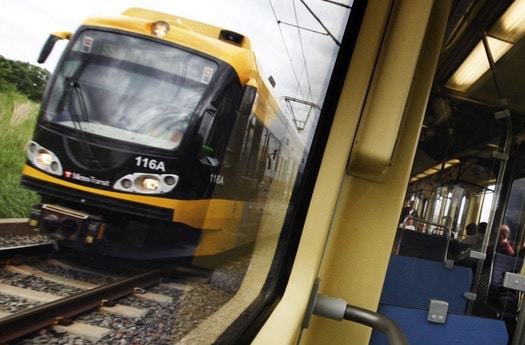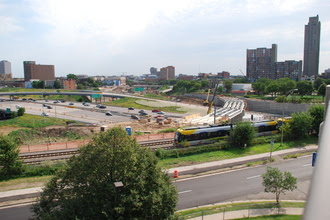
Bids to be opened on first construction contract in August, with fall award expected
Right: Crews construct a flyover in 2011 above Interstate 35W to tie the METRO Green Line to the Blue Line in Minneapolis
Contractors vying to build the largest public works project in Minnesota history should learn this fall who is the successful bidder on the first of three large construction contracts and be able to begin initial construction activities around the end of the year.
After the Southwest LRT Project opens bids Aug. 15 for the civil contract, a panel of technical experts will need about three months to check bids for “responsiveness and responsibility.” This check ensures that bids include all construction activities and that they have met requirements such as insurance, performance bonds and Disadvantaged Business Enterprise goals (16 percent is the goal for the civil construction contract). The contract will be awarded in November to the lowest responsive and responsible bidder.
Civil construction involves the building of tracks, roads, bridges, trails, tunnels and park-and-ride facilities. Crews will build or install:
- 29 miles of track
- 15 stations
- Eight park-and-ride facilities: seven surface parking lots with more than 1,700 spaces and one 450-stall parking structure at SouthWest Station in Eden Prairie
- 110 retaining walls
- Roadways and trails
- Urban design and landscaping
- 29 new bridges for LRT trains, pedestrians, roadways and freight rail
- Modifications to seven existing bridges
- Six pedestrian tunnels
- Two “cut-and-cover” LRT tunnels: 580 feet under Highway 62 on the Eden Prairie-Minnetonka border, and 2,200 feet in the Kenilworth corridor in Minneapolis.
Other contracts are in the offing
The Metropolitan Council expects to award a contract in July for specialty freight track related to the project. Later this year, the Met Council also will advertise for bids for construction of an LRT operations and maintenance facility in Hopkins and for development of the electrical power, signaling and communications systems.
The specialty freight track contract needs to be awarded in July to allow lead time for production and delivery of track material in March 2018 so freight track relocation work in Hopkins and St. Louis Park can begin on schedule. Completing the freight track relocation is critical so crews can start constructing the Excelsior LRT Bridge in Hopkins. Building the bridge is one of the project’s time-critical elements due to the complexity of the bridge design, which spans over Excelsior Boulevard and freight tracks.
In other time-sensitive work, the Southwest LRT Project will seek authorization in July from the Counties Transit Improvement Board to order materials with long lead times for the assembly of the light rail vehicles, such as drive units, couplers, doors, truck assemblies and auxiliary power supply. The Metropolitan Council awarded Siemens a $118 million contract, which was 5 percent lower than the estimate, in December 2016 to build 27 light rail vehicles at its Sacramento, Calif., plant. The first light rail vehicle is to be delivered in 2019. The contract includes spare parts and tools to support operations and maintenance and an option to purchase vehicles to meet anticipated needs for the planned Blue Line Extension LRT Project.
|
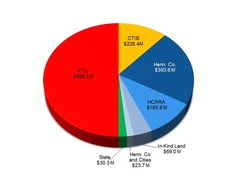
Southwest LRT Project moves forward after dissolution of transit board
Hennepin County is picking up the state’s capital and net operating cost shares of Southwest LRT following action by the Counties Transit Improvement Board to dissolve.
Left: Sources of funding; $928.8 million local funds committed
The transit board’s decision to dissolve by Oct. 1 clears the way for Hennepin County to increase its sales and use tax from a quarter cent to a half cent, which it approved on June 21.
The project is seeking half of its capital costs from the Federal Transit Administration, which continues to work with the project and has given it a coveted medium-high rating. The Met Council will apply in September with the FTA for a Full Funding Grant Agreement, which would be expected in early 2018. The FFGA is the federal government’s commitment to pay half the construction costs.
|
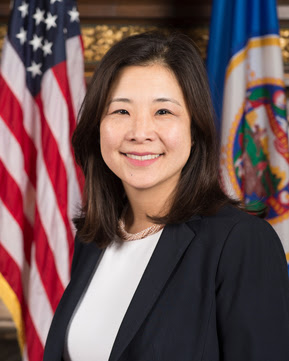
Met Council’s new chair has railroad background, been involved in SWLRT/freight rail talks
New Metropolitan Council Chair Alene Tchourumoff has more than a decade of transportation policy and finance experience and has been involved with the Southwest LRT Project in discussions with the affected freight rail companies.
Gov. Mark Dayton recently appointed Tchourumoff (pronounced CHUHR-uh-mahf) to succeed Adam Duininck. Her term will begin on July 31.
Left: Met Council Chair Alene Tchourumoff
For the past year, Tchourumoff has been the state’s rail director and worked on rail safety and economic development along rail corridors. Before becoming state rail director, she was director of the Planning Department for Hennepin County Public Works.
Tchourumoff previously was a manager for Deloitte Consulting in Washington, D.C., where she was a financial and strategic policy advisor to the Federal Railroad Administration at the U.S. Department of Transportation, focusing on rail program implementation and financing. She also previously was a manager in the transportation and finance practice for Infrastructure Management Group, advising the mayor of San Juan, Puerto Rico, the California High-Speed Rail Authority and Dallas Area Rapid Transit on rail policy and finance issues.
Current Chair Adam Duininck is stepping down to become government affairs director with the North Central States Regional Council of Carpenters. Duininck was appointed in 2015 to be the first full-time chair of the Met Council. He was first named to the Met Council in 2011, representing District 8, which covers part of Minneapolis. He was chair of the Met Council’s Transportation Committee in his first term. As the chair of both the Southwest LRT and Blue Line Extension LRT Projects’ corridor management committees, Duininck saw both projects complete the environmental process and the project development phase.
|
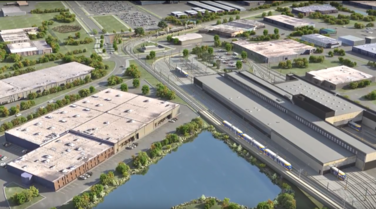
New visualizations show how LRT will look in St. Louis Park
Two new visualizations show the design of METRO Green Line Extension passenger stations at Louisiana Avenue Station and Blake Road Station in St. Louis Park and at Opus Station and Shady Oak Station in Minnetonka and Hopkins. Pedestrian and bicycle facilities and street intersections are also depicted. These visualizations join an earlier one of Hopkins posted on the project website, www.swlrt.org.
|
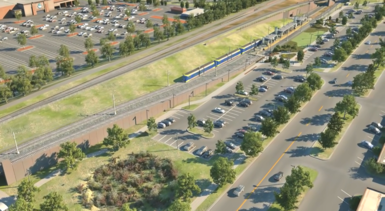 |
|
Above: Operations and Maintenance Facility at Shady Oak Station
Left: Louisiana Avenue Station
|
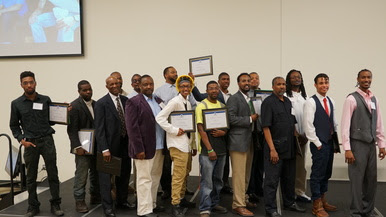
16 complete apprenticeship-readiness training to help prepare future LRT construction crews
Left: LRT Build Graduates
Sixteen people completed LRT Build at the end of June, a 10-week apprenticeship-readiness program to help prepare workers for construction jobs now that will give them work experience before heavy construction of Southwest LRT starts in 2018.
“They are qualified to become an apprentice. Once they get into their craft, they are going to be junior-level craft workers and doing whatever their craft needs of them,” said Richard Krohn, who taught the students basic construction skills at North Hennepin Community College.
Chevalier Gonzalez, one of the graduates, is grateful for the opportunity.
“These past 10 weeks have been a blur but the skills I have learned are going to help me for the rest of my life. I’m convinced that this program will help me enter the construction industry and for that I’m thankful for everybody who was part of this program. I’m just so excited to start a career in the construction industry,” Gonzalez said.
|
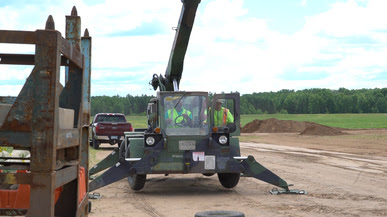
The Southwest LRT Project is expected to create 7,500 construction jobs, drawing workers from all over the state. Workforce goals for the project are 32 percent people of color and 6 percent female.
Left: LRT Build students at the Operators Engineers Union training center in Hinckley
Building light rail in the Twin Cities “will truly be your legacy for the region and will lift everyone up to be able to have better access to jobs, better access to school,” Metro Transit Deputy General Manager Mark Fuhrmann, who is program director for LRT projects, told the graduates at a commencement ceremony at North Hennepin Community College.
A second round of LRT Build classes will be offered in spring 2018.
The program is funded by the Metropolitan Council, Minneapolis Building and Construction Trades Council, North Hennepin Community College, Twin Cities R!SE, Hennepin-Carver Workforce Development Board, Construction Careers Foundation and McKnight Foundation. Gary Courtney and Jon Vang, Metropolitan Council equal opportunity consultants assigned to the two LRT projects, oversaw the LRT Build program.
|
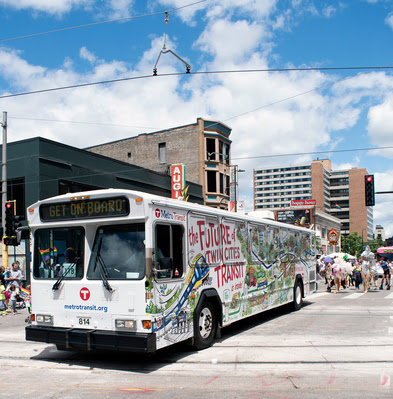
Outreach bus illustrates the “Future of Twin Cites Transit”
Kevin Cannon’s illustrations – what he calls “cartoon cartography” – helped memorialize the openings of the METRO Green and A Lines.
Left: New Outreach bus in Twin Cities Pride Parade
After depicting these routes in pieces that appeared in The Star Tribune and commemorative posters, Cannon was presented an even larger palette – a 40-foot bus that will travel to outreach activities across the Twin Cities.
The bus features illustrations of recognizable landmarks – water towers, parks and school buildings – from communities where planned extensions of the METRO Green and Blue lines will run.
The bus also denotes the Green, Blue and Red lines, and the planned Orange Line, and includes large text inviting people to imagine the “Future of Twin Cities Transit.”
The design was made in collaboration with Metro Transit’s Creative Services team. It debuted at the recent Pride Parade and will appear at dozens of community events through the end of the year.
Metro Transit recently caught up with Cannon to talk about his work.
How would you describe your style?
I think my style is best described as “cartoon cartography.” I try to capture the essence of a building or place through caricature but I don’t sweat the details, like accurate size relationships or navigability. Anyone who tries to use my maps to get from point A to point B will probably get lost. I think I can get away with “creative accuracy” because I’m a cartoonist, and fortunately this freedom to warp spatial relationships allows me to draw maps to fit strange and unique shapes like, say, the side of a bus.
How did you get your start?
Drawing has been a part of my life for as long as I can remember. My earliest memories are of drawing with Mr. Sketch markers on scraps of foam core rescued from my uncle’s photography studio. My freelance life began in high school when various teachers and coaches hired me to draw sports T-shirts and academic posters (and by “hired” I mean I was paid in free T-shirts). I studied painting at Grinnell College in Iowa, then spent a few months going broke in Manhattan, and eventually settled back in Minneapolis where I’ve been freelancing ever since. Most of my current work involves illustrating children’s books, but my favorite projects involve drawing cartoon maps.
What inspired your vision for this bus?
I’m extremely excited that Metro Transit is branching farther out into the community, making the amenities of Minneapolis and St. Paul accessible to everyone. Having lived briefly in New York City and London, I know what it’s like to wake up and be able to jump on a train and go nearly anywhere you want and it’s fun to see the Twin Cities move in that direction. Since I come from a train family – my great-grandpa used to take steam engines across the Stone Arch bridge — I’m particularly excited about the proposed light rail routes.
What do you hope people will take away from seeing the bus?
My hope is that people will get excited about how all the new routes will connect the Twin Cities and will inspire people to get out and explore. Hopefully my style and cartoon landmarks will catch peoples’ eyes as the bus passes and will encourage them to learn more about what Metro Transit has in the works over the next several years.
See more of Kevin Cannon’s work at kevincannon.org. Construction activities on the Green Line Extension, running from Minneapolis to Eden Prairie, are scheduled to begin late this year. Heavy construction on the Blue Line Extension, which will run from Minneapolis to Brooklyn Park, is scheduled to begin in 2019.The lines are scheduled to open in late 2021 and 2022, respectively.
|
About the Project:
The planned Southwest Light Rail Transit (LRT) Project (METRO Green Line Extension) will operate from downtown Minneapolis through the communities of St. Louis Park, Hopkins, Minnetonka, and Eden Prairie, passing in close proximity to the city of Edina. The line will connect major activity centers in the region including downtown Minneapolis, Methodist Hospital in St. Louis Park, downtown Hopkins and the Opus/Golden Triangle employment area in Minnetonka and Eden Prairie. Ridership in 2040 is forecasted at approximately 34,000 average weekday boardings. The project will interline with the METRO Green Line, which will provide a one-seat ride to destinations such as the University of Minnesota, state Capitol and downtown St. Paul. It will be part of an integrated system of transitways, including connections to the METRO Blue Line, the proposed METRO Blue Line Extension, the Northstar Commuter Rail line, a variety of major bus routes along the alignment, and proposed future transitway and rail lines. The Metropolitan Council will be the grantee of federal funds. The regional government agency is charged with building the line in partnership with the Minnesota Department of Transportation. The Southwest Corridor Management Committee, which includes commissioners from Hennepin County and the mayors of Minneapolis, St. Louis Park, Edina, Hopkins, Minnetonka, and Eden Prairie, provides advice and oversight. Funding is provided by the Federal Transit Administration, Counties Transit Improvement Board (CTIB), state of Minnesota and Hennepin County Regional Railroad Authority (HCRRA) and other project partners. The Southwest LRT Project website is www.swlrt.org
|
